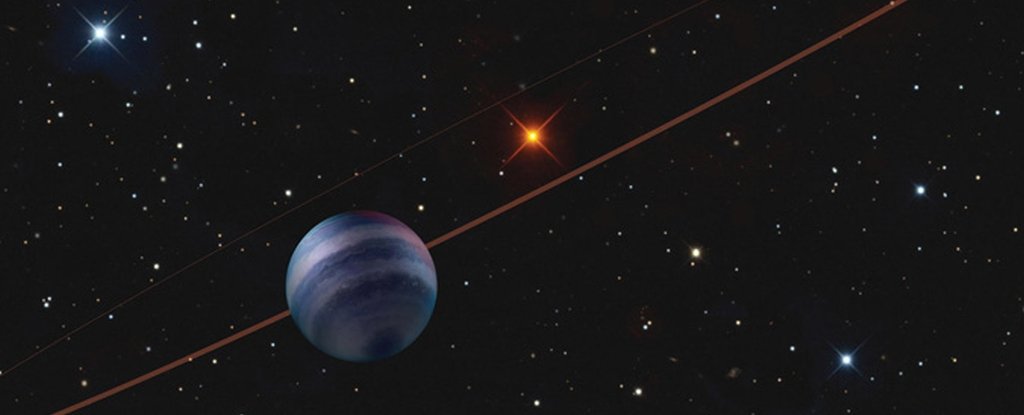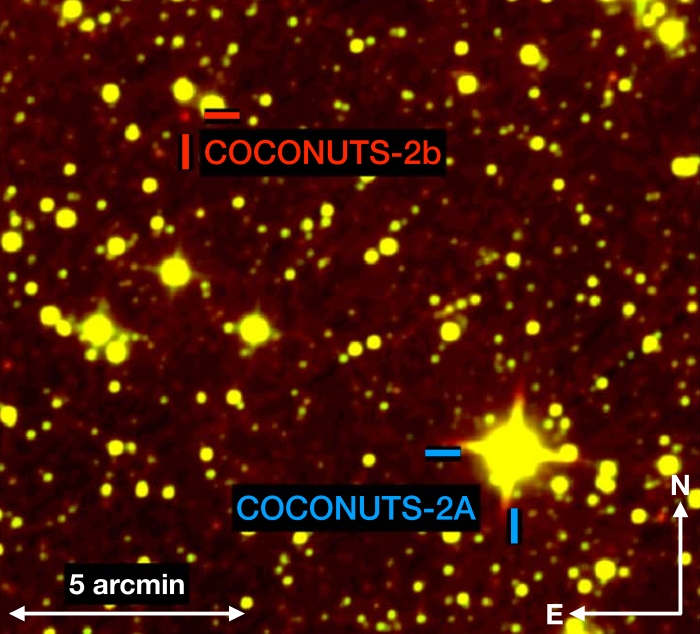
Posted on 07/29/2021 9:00:33 AM PDT by Red Badger

Illustration of COCONUTS-2b. (B. Bays/SOEST/UH)
==================================================================================
Exoplanets are tricksy little beasts.
As they are very small, very dim, and very far away, seeing them directly is extremely challenging and rare. As such, we usually infer their presence from their effects on their host stars – which means that when we do, on the odd occasion, see one directly, it's a cause for excitement.
And excitement is exactly what you should be feeling with the discovery of an exoplanet called COCONUTS-2b, orbiting a star called COCONUTS-2.
Not only is COCONUTS-2b (named for the COol Companions ON Ultrawide orbiTS survey) the closest directly imaged exoplanet to Earth to date – at a distance of just 35 light-years – it's a rarity among exoplanet discoveries: a relatively cool, massive gas giant, orbiting its star at a great distance.
"With a massive planet on a super-wide-separation orbit, and with a very cool central star, COCONUTS-2 represents a very different planetary system than our own Solar System," said astronomer Zhoujian Zhang of the University of Hawaiʻi Institute for Astronomy.

coconuts image COCONUTS-2b, red dot at top-left. (Zhang et al., The Astrophysical Journal Letters, 2021)
===================================================================================
The most common methods for detecting an exoplanet rely on two effects exoplanets might have on a host star. The first is called the transit method, and it relies on changes in the depth of a star's light. When an exoplanet passes between us and its host star on its orbital path, this transit is detectable as faint dips in the star's light.
The radial velocity (or 'wobble') method, relies on changes in the wavelength of a star's light. As the exoplanet orbits the star, it exerts a slight gravitational influence that causes the star to wobble minutely. As it moves in a small circular motion, the wavelength of its light shifts slightly as it moves towards and away from us.
Both these methods are best able to detect exoplanets that are massive, and close to the planet – massive, because the signal will be larger and easier to discern, and close because they orbit quickly, which means astronomers can obtain the multiple signals they need in order to confirm that they are caused by an orbiting body and not a random passing object.
It was, however, the large distance from its host star – around 6,471 astronomical units, which is 6,471 times the average distance between Earth and the Sun – that made COCONUTS-2b visible in direct images. At that distance, its orbital period is approximately 1.1 million years (which might be a record for a known exoplanet).
"Directly detecting and studying the light from gas-giant planets around other stars is ordinarily very difficult, since the planets we find usually have small-separation orbits and thus are buried in the glare of their host star's light," said astronomer Michael Liu of the University of Hawai'i.
What made it visible is that, although it's cool for a gas giant exoplanet, it's still pretty warm, with a temperature of around 434 Kelvin (161 degrees Celsius, or 322 degrees Fahrenheit), in spite of its distance from the warmth of the star.
COCONUTS-2b is still quite young, up to only around 800 million years; its warm temperature is residual heat from the exoplanet's formation, trapped inside the massive exoplanet, six times the mass of Jupiter. This heat means that the exoplanet faintly glows in infrared wavelengths – enough to be discernible in direct images.
Its huge orbital distance will have other benefits for future research, too. It may be able to help us better understand how gas giants form, a process that we still don't understand very well – and taking a closer look at it will help us better understand gas giant diversity.
"With its huge orbital separation, COCONUTS-2b will be a great laboratory for studying the atmosphere and composition of a young gas-giant planet," Liu said.
The research has been published in The Astrophysical Journal Letters:
https://iopscience.iop.org/article/10.3847/2041-8213/ac1123
X-O Planet Ping!...................
Great, now we can get two empty halves of a coconut and start banging them together!
We found them!
You put the lime in the coconut...
Is this where the Chinese Grocery Store.gets ™XO Sauce?”
You don’t want to know where XO sauce comes from......................
This makes me want to watch K-Pax again.
It is a little more than one tenth of a light year away from its star. At 6 times the mass of Jupiter it must have some big moons as well. Perhaps they could use the same techniques mentioned to find that out.
It is made of abalone and preserved ham.
Yes, but from where.......................
Lee Cum Lee is made.in Hong Kong
I see alien planets every night on the NASA channel 13.4 Heros channel.
So they are naming exoplanets after Marx Brothers movies now? The next one will be called HORSEFETHERS.
Thanks Red Badger.
 | ||
| · join · view topics · view or post blog · bookmark · post new topic · subscribe · | ||
| Google news searches: exoplanet · exosolar · extrasolar · | ||
Disclaimer: Opinions posted on Free Republic are those of the individual posters and do not necessarily represent the opinion of Free Republic or its management. All materials posted herein are protected by copyright law and the exemption for fair use of copyrighted works.